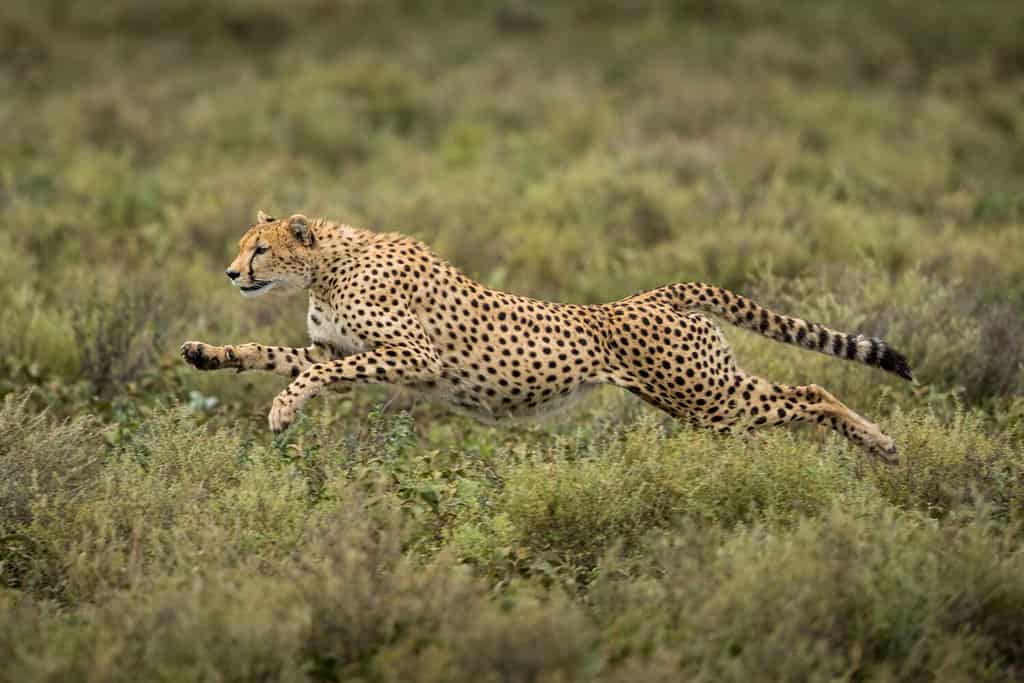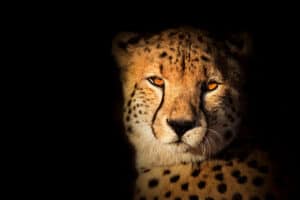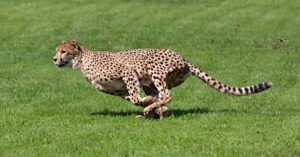
Cheetahs are born athletes.
©Stu Porter/Shutterstock.com
Seeing cheetah chases in action is awe-inspiring! The incredible speed and power of the big cat is easy to see. It overtakes the lure, skids to a stop, and turns to catch it throwing up a cloud of dust. Although this cheetah chases a lure, this is comparable to what they do in the wild. Lures give captive cheetahs the opportunity to chase.
A lure system uses a piece of rabbit or other prey tied to a string with a pulley system that runs at high speeds. Cheetahs can’t resist the chase! This lure game is one way Running Wild Cheetah Conservation (RWCC) teaches their cheetahs to hunt. They must learn this skill before release into the wild. This captivating example of the cheetah chasing its prey is one you won’t want to miss in the video below!
Watch the incredible chase in the video below!
How fast can a cheetah chase?
Cheetahs are the fastest land animals on Earth. They reach speeds of 70 mph (miles-per-hour) in a few seconds. But, they cannot maintain this speed for more than a few moments. They spend so much energy during these high-speed bursts, they have to rest for a long while after. That’s why cheetahs stalk their prey. They get as close as possible before springing into action. Then the chase is on! The cheetah will trip the animal with their front paw when they get close enough. When it falls, the cat suffocates them with a bite to the throat.

When a cheetah runs at full speed, all four paws leave the ground at the same time.
©Danita Delimont/Shutterstock.com
When cheetahs chase their prey, they coil and spring to reach those incredible speeds. They bring all their legs together and then extend their bodies. At full extension, all four paws leave the ground and the cat covers as far as 22 feet in a single bound! These cats have semi-retractable claws like domestic dogs. These blunt, rounded nails allow them to grip the ground as they run. They also use their long tail as a rudder, helping them steer and maintain balance. The cheetah’s deep chest houses its large heart and lungs. These organs are important for blood and oxygen flow during a chase. These cats have developed these traits to help them survive their harsh environment.
What do cheetahs eat?
Cheetahs hunt a variety of prey but will eat anything they can catch. This includes hoofed animals such as springboks and impalas. They will also hunt the calves of water buffalo and wildebeest, as well as, baby warthogs. These cats, like many cats, will also kill and eat birds and rabbits. Only 10% of cheetah chases end in a kill. They also have their kills stolen often by other predators, like lions and hyenas. It’s not easy to be a cheetah!

A young cheetah chases a baby springbok, one of their common prey items.
©iStock.com/StuPorts
Cheetahs have a long list of prey and adaptations to help them survive. But, cheetahs are still an endangered species. Only 7,500-10,000 still live in the wild. Humans are responsible for this. Poachers hunt them for their beautiful spotted coats. Habitat loss and human-cheetah conflict are also major factors. Many farmers kill cheetahs who hunt farm animals. The farmers do this to protect their livelihood but the cheetahs don’t understand. The farm animals look like food to them!
Many people around the world are striving to restore the population. Cheetah Conservation Fund is an international organization dedicated to saving wild cheetahs. RWCC breeds and releases cheetahs to their natural habitat. Their process, called re-wilding, has allowed many cheetahs to go back to the wild. Re-wilding means that they teach the cheetah how to hunt and survive on their own.
They do this with minimal contact so that the cats do not learn to trust humans or associate them with food. Re-wilding increases the chances that the cheetahs will be successful. The goal is for them to go on to reproduce in the wild. This process is essential for rebuilding the wild cheetah population.
Is it Normal for Cheetahs to Run at Top Speed?
Cheetahs were made for speed and are capable of reaching speeds close to 70 miles per hour – but do they? Alan Wilson of the Royal Veterinary College has shown just how much speed a cheetah needs. Wilson developed a collar that measures the cheetah’s explosive take-off and acceleration from its first footfalls to the death of its prey.

Cheetahs are often photographed running across level land – but they can also run at high speeds through thick vegetation.
©Marcel Brekelmans/Shutterstock.com
The published top speed of a cheetah is 64 mph, much faster than a greyhound at 40 mph or a racehorse at 42 mph. These were based on measurements taken in the 1960s. Whenever Wilson clocked second and third-generation captive cheetahs chasing lures on strings, they only ran at greyhound level. A trip to Africa was in order.
Wilson was able to work with a charity in Botswana that had been studying cheetahs using tracking collars. The collars were replaced with his speed-recording trackers. By overlaying the info into maps of the terrain captured through Google Earth, he was able to uncover some amazing new facts! In one hunt, he could see a cheetah using a termite mound to bank before taking off! His collars could even detect whether the cheetahs killed their prey or when they got away.
Out of 367 runs – only a quarter ended in a kill. Another surprising finding was that cheetahs make half their runs among shrubs or thick vegetation – and actually were more successful when they did. One of the fastest cheetahs reached 59 mph through dense vegetation! It seems that cheetahs are just as capable of extreme maneuverability as they are of speed. Cheetahs can dart and weave in-between vegetation and, unlike most of their prey – perform sharp turns on a dime before gearing up and accelerating again!
Cheetahs possess powerful leg and back muscles that makeup half its body. The cats can speed up or slow down by up to 9 mph in one individual stride. Across most hunts, the cheetahs’ top speeds averaged around 33 mph. Wilson plans to attach collars to a coalition of cheetahs – to see how they work together and how much speed is needed when hunting in a group. Cheetahs are much more than the fastest animal on Earth – they may be the most agile and best all-around athlete as well!
The photo featured at the top of this post is © iStock.com/slowmotiongli
Thank you for reading! Have some feedback for us? Contact the AZ Animals editorial team.







